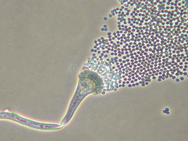Fungi – The Fascinating World of Molds and Yeasts in Nature, Health and Disease
Molds and Yeasts – Colonies and Cells Compared and Contrasted
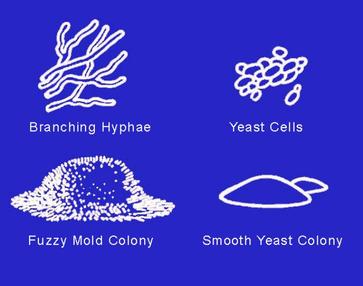
Mold and Yeast Colonies and Mold Hyphae and Budding Yeast Cells
Mold colonies are fuzzy and usually fluffy or powdery in appearance. Mold colonies tend to spread outward and across larger areas of an agar plate or suitable food sources such as bread, fruits and vegetables. As molds grow they disfigure the food item and cause it to become of unsuitable appearance and flavor or taste. Mold colonies impart a "moldy" odor to their substrates. Occasionally, they cause allergies in some people and molds can infect plants, animals or people and cause serious disease as shown later.
Yeast colonies are more contact and round and dome-shaped. The yeast colonies grow to a certain size and stop. In contrast to mold colonies, yeast colonies are limited in their diameter. On the other hand, mold colonies continue to spread and they can cover an entire plate or surface of a food such as a melon or cheese. Yeasts and their colonies impart a sweet odor to the air as they ferment sugars. These yeasts extract energy from the sugar and often produce small or larger amounts of ethanol (alcohol) which accounts in poart for the sweet odor. Yeasts are common fermenters of sugars and are valuable for baking, and the brewing of beers, wines and whiskies.
Yeast colonies are more contact and round and dome-shaped. The yeast colonies grow to a certain size and stop. In contrast to mold colonies, yeast colonies are limited in their diameter. On the other hand, mold colonies continue to spread and they can cover an entire plate or surface of a food such as a melon or cheese. Yeasts and their colonies impart a sweet odor to the air as they ferment sugars. These yeasts extract energy from the sugar and often produce small or larger amounts of ethanol (alcohol) which accounts in poart for the sweet odor. Yeasts are common fermenters of sugars and are valuable for baking, and the brewing of beers, wines and whiskies.
Mycology – A Dozen Important Definitions,Terms, Facts, Insights
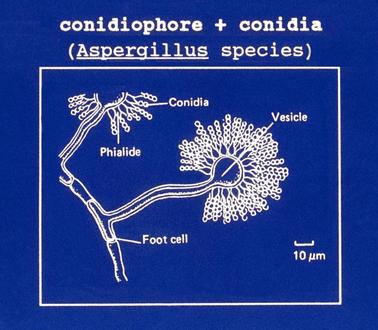
Aspergillus Diagram with Conidia, Philaides and Hyphae
Mycologists are those who study fungi. And the science and study of fungi is termed mycology. Some fungi such as mushrooms, toadstools, puffballs and related fungi are seen easily – they are macroscopic and they are visible to the naked eye. Other fungi are microscopic and require a magnifying lens system to see them. Regardless of who sees or even knows about fungi they are important in our world of planet earth. Fungi influence the environment, plants, animals and people in ways that are both evident and not so evident.
To better understand fungi it is good to know some basic terms of mycology and here are a dozen of the most important terms and definitions.
Mycology – the study of fungi – the molds and yeasts
Mycologist – a scientist or person who studies or investigates fungi
Fungus – an organism composed of one or more cells that uses organic food for growth (heterotrophic nutrition) and has a true nucleus (membrane-bound nucleus and is, therefore, eukaryotic). Fungi are of mold or yeast types.
Mold – a filamentous fungus that produces hyphae (thread-like structures and usually spores or condia for vegetative reproduction. Examples: Aspergillus, Peniciilium, Rhizopus.
Yeast – a single-celled, eukaryotic (membrane-bound nucleus) fungus that usually reproduces by budding. Examples: Candida, Cryptococcus, Saccharomyces.
Hypha (pl. hyphae) – a filament of a fungus that contains either chitin or cellulose or chitin-cellulose fibers. Hyphae expand at the tips and may or may not branch.
Blastoconidium – a bud of yeast cells. Buds serve to reproduce or vegetatively (asexually) multiply the yeast.
Conidium (pl. conidia) – a spore type produced by many of the molds. Conidia serve to vegetatively (sexually) multiply or reproduce the mold. There are different types of conidia that can be seen and studied.
Spore – an asexual reproductive structure of some molds such as zygomycetes.
Asexual spores, conidia – reproduced by mitotic division only.
Sexual spores – spores that are the result of nuclear fusion followed by meiosis or reduction division.
Classes of fungi – there are 4 main classes of fungi. 1. Ascomycota – fungi that produce ascopsores as a result of nuclear fusion followed by meiosis. The spores are contained in a sac (ascus) and number 4 or 8 ascospores. 2. Basidiomycota – fungi that produce basidiospores externally on a club-shaped structure (basidium). The spores are the result of nuclear fusion followed by meiosis. 3. Zygomycota – fungi that produce zygospores. Zygospopres are thick-walled products of hyphal union and fusion. 4. Deuteromycota – an asexual class of fungi that typically do not have an obvious sexual stage but do have distinct asexual condia or spores.
To better understand fungi it is good to know some basic terms of mycology and here are a dozen of the most important terms and definitions.
Mycology – the study of fungi – the molds and yeasts
Mycologist – a scientist or person who studies or investigates fungi
Fungus – an organism composed of one or more cells that uses organic food for growth (heterotrophic nutrition) and has a true nucleus (membrane-bound nucleus and is, therefore, eukaryotic). Fungi are of mold or yeast types.
Mold – a filamentous fungus that produces hyphae (thread-like structures and usually spores or condia for vegetative reproduction. Examples: Aspergillus, Peniciilium, Rhizopus.
Yeast – a single-celled, eukaryotic (membrane-bound nucleus) fungus that usually reproduces by budding. Examples: Candida, Cryptococcus, Saccharomyces.
Hypha (pl. hyphae) – a filament of a fungus that contains either chitin or cellulose or chitin-cellulose fibers. Hyphae expand at the tips and may or may not branch.
Blastoconidium – a bud of yeast cells. Buds serve to reproduce or vegetatively (asexually) multiply the yeast.
Conidium (pl. conidia) – a spore type produced by many of the molds. Conidia serve to vegetatively (sexually) multiply or reproduce the mold. There are different types of conidia that can be seen and studied.
Spore – an asexual reproductive structure of some molds such as zygomycetes.
Asexual spores, conidia – reproduced by mitotic division only.
Sexual spores – spores that are the result of nuclear fusion followed by meiosis or reduction division.
Classes of fungi – there are 4 main classes of fungi. 1. Ascomycota – fungi that produce ascopsores as a result of nuclear fusion followed by meiosis. The spores are contained in a sac (ascus) and number 4 or 8 ascospores. 2. Basidiomycota – fungi that produce basidiospores externally on a club-shaped structure (basidium). The spores are the result of nuclear fusion followed by meiosis. 3. Zygomycota – fungi that produce zygospores. Zygospopres are thick-walled products of hyphal union and fusion. 4. Deuteromycota – an asexual class of fungi that typically do not have an obvious sexual stage but do have distinct asexual condia or spores.
Aspergillus, a Mold with Spores (Phialocondia) and Hyphae (Threads)
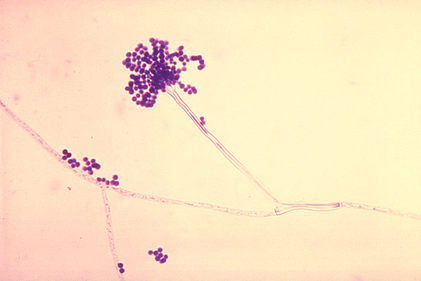
Aspergillus Mold with Hyphae and Spores (CDC Photo Library)
Aspergillus is a common mold that is found throughout the world. It is a mold with characteristic hyphae and crosswalls as shown in the photo here to the left. Notice the cluster of round spores or condia (phialoconidia). Aspergillus, similar to other filamentous fungi, grows by extension at the tips of the hyphae. At certain times upshoots or condiophores rise from the substrate (agar, food, fruit, vegetable) and into the air. Next, the condiophores form specialized phialides which extrude spores into the chains shown in this photo. Notice also that the newest or youngest sopores are at the bottom and the oldest, more mature sopores are at the top. Some species of Aspergillus, as well as some other molds, cause allergies of the respiratory tract or skin reactions (contact dermatitis). Some cases of asthma and bronchitis have been linked to spores of Aspergillus.
Candida albicans, Common, Budding Yeast & Occasional Human Pathogen
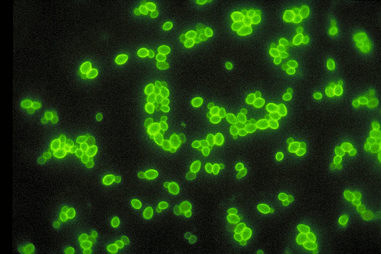
Candida albicans Yeast Cells
Candida albicans is a budding yeast. The yeasts produce blastospores which are extruded at one side or pole of the yeast. Candida yeasts are fairly common and are often found on human mucous membranes in the gastrointestinal (GI) and reproductive tracts. Under certain conditions such as diabetes, pregnancy, hormonal changes of estrogen-progesterone, or during the use of corticosteroids (e.g. prednisone) or anti-bacterial antibiotics, Candida may grow vigorously, become invasive and cause disease. During these unbalanced or changed physiological and chemical conditions, the yeasts tend to form pseudohyphae and hyphae which promote the invasiveness of Candida albicans into the mucous membranes and occasionally into deeper tissue. Candidemias, or blood infections with Candida. are known to occur in certain disease situations. Even heart damage to the lining and valves of the heart has been linked to candidemias associated with habitual IV-drug use.
Growth Conditions for Molds and Yeasts
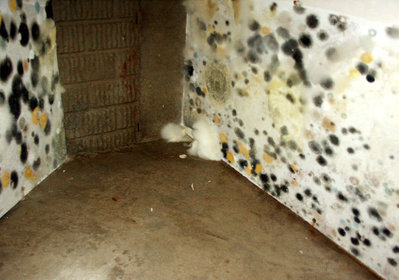
Large Mold Colonies on Wallboard of Moist Basement (Credit: HUD, U.S.)
All living things need a source of carbon and nitrogen, water, and an assortment of minerals such as iron, magnesium, phosphorous and sulfur. Some fungi are more complex that others in terms of their nutritional needs. Most molds and yeasts typically prefer sugar as a source of carbon and either ammonium nitrate (NH4NO3) or simple amino acids as a nitrogen source. Yeasts like natural sugars and plant saps and exudates with sugars are natural environmental sources for these sugars.
Molds and yeasts may produce extracellular enzymes (exoenzymes) that can digest polysaccharides such as starch (enzyme = amylase) or cellulose (enzyme = cellulase). When these enzymes are released from the fungus to the surrounding environment, those enzymes can degrade and change the polysaccharides into simple glucose sugar that is easily absorbed by the fungus. The photo to the left shows that paper on wallboard that is being digested by several different molds. The nutritious glucose sugar formed from the molds' cellulose digestion feeds the moldy growth which expands quickly. Each of the darker and lighter circles represents colonies of mold. Many of these colonies started as a single mold spore.
With adequate food, water, and an acceptable temperature these hetertrophic, eukaryotes grow and reproduce rapidly. Under less than ideal conditions molds and yeasts grow slowly. For example, where there is water condensation or high humidity, molds can grow on glass windows and plastic surfaces. In moist basements – such as pictured here above – molds can attack wood and wallboard using cellulases to digest wallboard cellulose into simple and nutritious glucose molecules. For many homeowners or renters prevention and control of basement mold is a chore and a challenge. Mold control will be discussed in more detail later.
Molds and yeasts may produce extracellular enzymes (exoenzymes) that can digest polysaccharides such as starch (enzyme = amylase) or cellulose (enzyme = cellulase). When these enzymes are released from the fungus to the surrounding environment, those enzymes can degrade and change the polysaccharides into simple glucose sugar that is easily absorbed by the fungus. The photo to the left shows that paper on wallboard that is being digested by several different molds. The nutritious glucose sugar formed from the molds' cellulose digestion feeds the moldy growth which expands quickly. Each of the darker and lighter circles represents colonies of mold. Many of these colonies started as a single mold spore.
With adequate food, water, and an acceptable temperature these hetertrophic, eukaryotes grow and reproduce rapidly. Under less than ideal conditions molds and yeasts grow slowly. For example, where there is water condensation or high humidity, molds can grow on glass windows and plastic surfaces. In moist basements – such as pictured here above – molds can attack wood and wallboard using cellulases to digest wallboard cellulose into simple and nutritious glucose molecules. For many homeowners or renters prevention and control of basement mold is a chore and a challenge. Mold control will be discussed in more detail later.
Eukaryotic Fungi Differ from Prokaryotic Bacteria – Cellular Differences
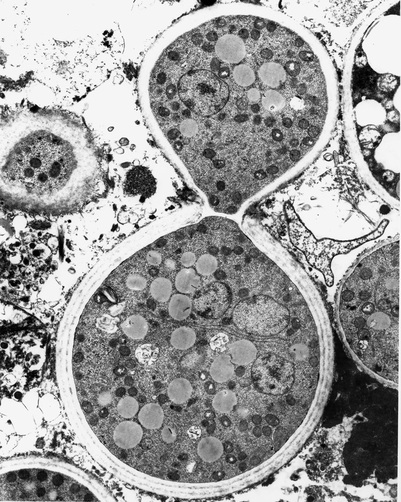
Yeast (Blastomyces dermatitidis) in Patient, U.S. Veterans Administration
Molds and yeasts are primitive and succussful eukaryotes. Although considered microorganims by many, fungi are larger than typical bacteria in size and are more complicated in structure.
A typical bacterial and yeast cell when compared differ in size, genetics, chemical structure and complexitiy. Bacteria average about 1 micrometer in width and 1 to 3 micrometers in length. Yeasts are at least 2-3 micrometers in diameter and they are often larger.
Bacteria are simpler cells and they have a nucleus or nucleoid structure of DNA without a membrane surrounding or enclosing the nucleus. Therefore,the DNA is always in immediate and direct contact with the bacterial cytoplasm. Bacteria are considered primitive cells with primitive nuclei and all bacteria are called prokaryotes.
In contrast to this prokaryotic bacterial nucleus, the yeast cell nucleus has a membrane or DNA envelope (i.e is eukaryotic). The yeast's cytoplasm also contains two structures not present in bacteria – an endoplasmic reticulum and at least one or more mitochondria which serve to generate chemical energy in the form of ATP by oxidation. Bacteria lack an endoplasmic reticulum and are themselves no larger that a mitochondrion. In fact, some people speculate that mitochondria are really vestiges of endosymbiotic bacteria that once long ago invaded larger cells and became partners with these cells in a mutualistic symbiosis. Mutualistic symbiosis indicates a situation where two organisms live together and each organism contributes to the survival of the other. In contrast, parasites live in or on another organism, the parasite benefits and the host does not and there is harm to the host organism. Viruses are an example of obligate parasites and a parasitic symbiosis.
Finally, both eukaryotes and prokaryotes contain ribosomes which are used for protein synthesis. Even the ribosomes differ in weight and size between prokaryotes and eukaryotes. Prokaryotes are of 70S (S = Svedberg molecular weight unit) size and 80S the larger size ribosomes are found in all eukaryotic cells.
A typical bacterial and yeast cell when compared differ in size, genetics, chemical structure and complexitiy. Bacteria average about 1 micrometer in width and 1 to 3 micrometers in length. Yeasts are at least 2-3 micrometers in diameter and they are often larger.
Bacteria are simpler cells and they have a nucleus or nucleoid structure of DNA without a membrane surrounding or enclosing the nucleus. Therefore,the DNA is always in immediate and direct contact with the bacterial cytoplasm. Bacteria are considered primitive cells with primitive nuclei and all bacteria are called prokaryotes.
In contrast to this prokaryotic bacterial nucleus, the yeast cell nucleus has a membrane or DNA envelope (i.e is eukaryotic). The yeast's cytoplasm also contains two structures not present in bacteria – an endoplasmic reticulum and at least one or more mitochondria which serve to generate chemical energy in the form of ATP by oxidation. Bacteria lack an endoplasmic reticulum and are themselves no larger that a mitochondrion. In fact, some people speculate that mitochondria are really vestiges of endosymbiotic bacteria that once long ago invaded larger cells and became partners with these cells in a mutualistic symbiosis. Mutualistic symbiosis indicates a situation where two organisms live together and each organism contributes to the survival of the other. In contrast, parasites live in or on another organism, the parasite benefits and the host does not and there is harm to the host organism. Viruses are an example of obligate parasites and a parasitic symbiosis.
Finally, both eukaryotes and prokaryotes contain ribosomes which are used for protein synthesis. Even the ribosomes differ in weight and size between prokaryotes and eukaryotes. Prokaryotes are of 70S (S = Svedberg molecular weight unit) size and 80S the larger size ribosomes are found in all eukaryotic cells.
Control, Remediation of Molds and Mold Growth, Preventative Measures
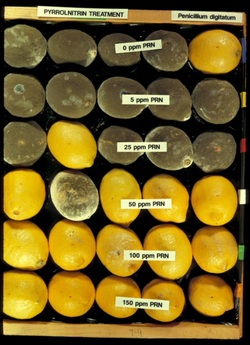
Penicillium mold on Lemons and Control by Fungicide
Fungal Spores – Features and Characteristics
Vegetative mold spores are resistant, reproductive, parts of a fungus that under the right conditions can produce more mold. Depending upon the growth conditions, fungus spores may be produced by the thousands or millions in a few hours or days. Fungus spores may be spread by insects and many different physical effects contribute to spore distribution in the environment: wind or air currents, rain, water, vibrations, or physical impact such as shoes or feet treking across a moldy floor or surface. Spores, therefore, can move about quickly and easily. Spores may be transmitted to many different places unknowingly on shoes, clothing, hands, etc.
Mold spores tend to be somewhat resistant to heat, drying, and chemicals when compared to the vegetative cells or hyphae. However, ozone, heating or boiling, alcohol, quaternary ammonium compounds ("quats"), bleach can kill thinner fungus hyphae and even thicker-walled spores. These killing or "cidal" effects are dependent on treatment time, intensity or concentration. Special laboratory tests can be done to determine the best (optimum) kill conditions for any particular treatment.
Control of Molds, Spores and Measures for Mold Remediation – Explanations and Insights
Molds thrive where there is: 1. moisture and humidity, 2. oxygen, 3. sufficient nutrients and an 4. adequate growth temperature (about 20-40 degrees Centigrade). Nevertheless, even under cool conditions – as in a refrigerator – many molds can grow on foods such as cheeses, fruits and vegetables. The photo of mold on wallboard in a wet basement can lead to massive damage to the wall and the environment. The situation of that basement is unhealthy as well as unsightly. Allergic skin reactions and allergies may be triggered by mold spores and mold chemical vapors released into the environment.
Most large scale mold remediation such as is needed in basements, underflooring, attics, or house living areas with moldy carpet, walls and ceiling, is usually a job for experts or professionals and should not be attempted by untrained, ill-equipped, non-experts.
Molds are often nourished by water and high humidity as well as a few essential other nutrients. Since molds are found almost everywhere, you are bound to encounter them quite often. Remember to deprive molds of food and humidity and your air will smell and feel much cleaner and healthier for you and all others who visit you there.
Resource
Microbiology, Principles and Explorations. 1999. J.G. Black. John Wiley & Sons, Inc., New York. 786 pp.
Vegetative mold spores are resistant, reproductive, parts of a fungus that under the right conditions can produce more mold. Depending upon the growth conditions, fungus spores may be produced by the thousands or millions in a few hours or days. Fungus spores may be spread by insects and many different physical effects contribute to spore distribution in the environment: wind or air currents, rain, water, vibrations, or physical impact such as shoes or feet treking across a moldy floor or surface. Spores, therefore, can move about quickly and easily. Spores may be transmitted to many different places unknowingly on shoes, clothing, hands, etc.
Mold spores tend to be somewhat resistant to heat, drying, and chemicals when compared to the vegetative cells or hyphae. However, ozone, heating or boiling, alcohol, quaternary ammonium compounds ("quats"), bleach can kill thinner fungus hyphae and even thicker-walled spores. These killing or "cidal" effects are dependent on treatment time, intensity or concentration. Special laboratory tests can be done to determine the best (optimum) kill conditions for any particular treatment.
Control of Molds, Spores and Measures for Mold Remediation – Explanations and Insights
Molds thrive where there is: 1. moisture and humidity, 2. oxygen, 3. sufficient nutrients and an 4. adequate growth temperature (about 20-40 degrees Centigrade). Nevertheless, even under cool conditions – as in a refrigerator – many molds can grow on foods such as cheeses, fruits and vegetables. The photo of mold on wallboard in a wet basement can lead to massive damage to the wall and the environment. The situation of that basement is unhealthy as well as unsightly. Allergic skin reactions and allergies may be triggered by mold spores and mold chemical vapors released into the environment.
Most large scale mold remediation such as is needed in basements, underflooring, attics, or house living areas with moldy carpet, walls and ceiling, is usually a job for experts or professionals and should not be attempted by untrained, ill-equipped, non-experts.
- For mold remediation one should receive at least 3 different estimates by licensed and insured contractors who can supply the names and phone number of no less than 5 referenced customers who may be called for recommendations.
- The necessary equipment for professional safe mold remediation includes: protective clothing that can be discarded or bagged and washed, goggles, gloves, N95 respirator masks and sealable, disposal bags for contaminated moldy materials.
- Individuals with allergies and allergic reactions should avoid exposure or contact with molds. Some individuals have an increased risk for fungus infections: diabetics, corticosteroid users, immunosuppressed persons, pregnant women and transplant patients.
- Fungicidal-certified sprays are available in cans at almost any big box, food, dollar and convenience store. The directions are on each can and should be read by any user before application. Typically, fungicidal sprays are sprayed over the whole contaminated surface and allowed to remain there for about 10 to 20 minutes. Next, a second light, surface spraying follows and items that are not to be discarded can then be cleaned by wiping the surface with gloved hands and a clean cloth while spraying and misting lightly. The contaminated item's surface or finish may be damaged by the fungus or the spray or both. If anyone attempts to disinfect furniture surfaces remember to carefully read everything and follow the instructions printed on the container or box..
- Remember, also, that untreated fungi and their spores will spread and disseminate if touched or moved prior to disinfection or fungicidal treatment. Spraying, as indicated above, is a necessity to avoid spore survival, transfer and dissemination. If there is a need to move a molded item to a discard bag remember to spray the molded item first and let it remain for 10 to 20 minutes to kill the mold. After this treatment the item is lifted carefully and placed into a large opened bag. Next the bag is sealed to prevent any spore release (Note: most spores will be killed by the fungicide spray treatment). The gloved hands used for disposal can be washed with soap and ample running water to remove mold residue. Reusable gloves may be washed with soap and water and disinfected with antifungal spray.
- Moldy papers, books, cardboard and even some wood items may be so contaminated that they are useless. Those items are spray disinfected and discarded. Some wood or plastic items with molds may look and be fine after spray disinfection and cleaning with a fresh cloth or paper towel.
- It is important to remove high humidity and moisture from the air wherever and whenever possible. First, for personal comfort lower humidity (60 to 75 %) is better than higher humidity (8o to 100%). Molds love high humidity levels and thrive in it. Therefore, air conditioners and dehumidiers are the equipment of choice to get the humidity to levels that inhibit or discourage mold growth. Air conditioners and dehumidifiers should have condenstate lines that drain or empty collected water condensate to the outside.
- Dessicant bags of silica gel are used in small closets by some people to control mold growth on clothing and shoes stored there.
- A humidity meter is useful to have. Some dehumidifiers have built in meters that show the level of air-borne water.
Molds are often nourished by water and high humidity as well as a few essential other nutrients. Since molds are found almost everywhere, you are bound to encounter them quite often. Remember to deprive molds of food and humidity and your air will smell and feel much cleaner and healthier for you and all others who visit you there.
Resource
Microbiology, Principles and Explorations. 1999. J.G. Black. John Wiley & Sons, Inc., New York. 786 pp.
All the Written Material within Site is Copyrighted 2010 and Owned by Dr. Donald Reinhardt, and this original material is protected legally by this copyright notice and by the Digital Millennium Act. None of this original material may be copied or reproduced without the expressed written consent of the author.
The author is a Freelance Science writer, and is available for specific assignments for those who are interested – by contacting adminstrator@sciencesuperchool.com. Other questions related to this teaching site should be directed to teacher@sciencesuperschool.com.
The author is a Freelance Science writer, and is available for specific assignments for those who are interested – by contacting adminstrator@sciencesuperchool.com. Other questions related to this teaching site should be directed to teacher@sciencesuperschool.com.
